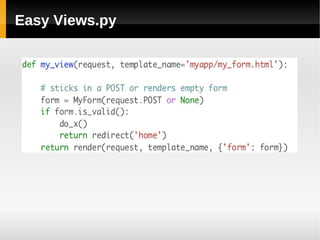A Basic Django Introduction
- 1. Web Development With Django A Basic Introduction Ganga L
- 2. Python Frameworks Django CherryPy Pylons Flask Bottle Tipfy Pyramid Cubic Web GAE framework
- 3. Outline What Is Django? Project Structure Data Handling The Admin Interface Django Forms Views Templates
- 4. What Is Django? High-level framework for rapid web development Complete stack of tools Data modelled with Python classes Production-ready data admin interface, generated dynamically Elegant system for mapping URLs to Python code Generic views’ to handle common requests Clean, powerful template language Components for user authentication, form handling, caching . . .
- 5. Creating Projects & Apps Creating a project: django-admin.py startproject mysite Creating an app within a project directory: cd mysite ./manage.py startapp poll
- 6. Project Structure A Python package on your PYTHONPATH Holds project-wide settings in settings.py Holds a URL configuration (URLconf) in urls.py Contains or references one or more apps
- 7. App A Python package on your PYTHONPATH (typically created as a subpackage of the project itself) May contain data models in models.py May contain views in views.py May have its own URL configuration in urls.py
- 8. Up & Running Set PYTHONPATH to include parent of your project directory Define new environment variable DJANGO_SETTINGS_MODULE, setting it to project settings (mysite.settings) 3 Try running the development server: /manage.py runserver
- 9. Creating The Database Create database polls in youe database Sync installed apps with database: ./manage.py syncdb
- 10. Create Project Create Project mysite mysite/ manage.py mysite/ __init__.py settings.py urls.py
- 11. Create Application python manage.py startapp polls polls/ __init__.py models.py tests.py views.py
- 12. Create Models from django.db import models class Poll(models.Model): question = models.CharField(max_length=200) pub_date = models.DateTimeField('date published') class Choice(models.Model): poll = models.ForeignKey(Poll) choice_text = models.CharField(max_length=200) votes = models.IntegerField(default=0)
- 13. The Data Model A description of database layout, as a Python class Normally represents one database table Has fields that map onto columns of the table Many built-in field types CharField, TextField IntegerField, FloatField, DecimalField DateField, DateTimeField, TimeField EmailField, URLField ForeignKey . . .
- 14. Installed App INSTALLED_APPS = ( 'django.contrib.admin', 'django.contrib.auth', 'django.contrib.contenttypes', 'django.contrib.sessions', 'django.contrib.messages', 'django.contrib.staticfiles', 'polls', ) python manage.py syncdb
- 15. Registering Models in Admin In admin.py in the Poll app: from django.contrib import admin from mysite.polls.models import Poll admin.site.register(Poll)
- 16. In urls.py: from django.conf.urls import patterns, include, url from django.contrib import admin admin.autodiscover() urlpatterns = patterns('', url(r'^admin/', include(admin.site.urls)), )
- 17. Generic Views Provide ready-made logic for many common tasks: Issuing a redirect Displaying a paginated list of objects Displaying a ‘detail’ page for a single object Yearly, monthly or daily listing of date-based objects ‘Latest items’ page for date-based objects Object creation, updating, deletion (with/without authorisation)
- 18. Generic Views Example views.py def index(request): return HttpResponse("Hello, world. You're at the poll index.") Url.py from django.conf.urls.defaults import * from polls import views urlpatterns = patterns('', url(r'^$', views.index, name='index') ) Main URL.py from django.conf.urls import patterns, include, url from django.contrib import admin admin.autodiscover() urlpatterns = patterns('', url(r'^polls/', include('polls.urls')), url(r'^admin/', include(admin.site.urls)), )
- 19. Creating & Saving Objects Invoke constructor and call save method: call create method of Club model manager: poll = Poll(question='what is your DOB? ', year='1986) poll.save() Poll.objects.create(question='what is your DOB? ', year='1986)
- 20. View Function Takes an HTTPRequest object as a parameter Returns an HTTPResponse object to caller Is associated with a particular URL via the URLconf
- 21. HTTP Response from datetime import date from django.http import HttpResponse def today(request): html = '<html><body><h2>%s</h2></body></html>' % date.today() return HttpResponse(html) from django.shortcuts import render_to_response From mysite.polls.models import Poll def poll_details(request): today = date.today() poll_data = Poll.objects.all() return render_to_response('clubs.html', locals(), context_instance = RequestContext(request))
- 22. Templates Text files containing Variables, replaced by values when the template is rendered[ {{ today }} Filters that modify how values are displayed {{ today|date:"D d M Y" }} Tags that control the logic of the rendering process {% if name == "nick" %} <p>Hello, Nick!</p> {% else %} <p>Who are you?</p> {% endif %}
- 23. Template Example settings.py TEMPLATE_DIRS = ( os.path.join(os.path.dirname(__file__), 'templates'), ) templates/club/club_list.html {% extends "base.html" %} {% block title %}Clubs{% endblock %} {% block content %} <h1>Clubs</h1> <ol> {% for club in clubs %} <li>{{ club }}</li> {% endfor %} </ol> {% endblock %}
- 24. Django Forms A collection of fields that knows how to validate itself and display itself as HTML. Display an HTML form with automatically generated form widgets. Check submitted data against a set of validation rules. Redisplay a form in the case of validation errors. Convert submitted form data to the relevant Python data types.
- 25. Django Model Forms from django.forms import ModelForm import mysite.polls.models import Poll class PollForm(ModelForm): class Meta: model = Pole
- 26. A Basic Django Forms
- 30. Easy Views.py
- 31. Easy Views.py
- 32. Summary We have shown you The structure of a Django project How models represent data in Django applications How data can be stored and queried via model instances How data can be managed through a dynamic admin interface How functionality is represent by views, each associated with URLs that match a given pattern How views render a response using a template
- 33. Thank You

































